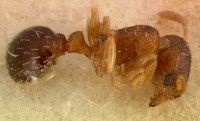Tetramorium caldarium
| Tetramorium caldarium | |
|---|---|

| |
| Scientific classification | |
| Kingdom: | Animalia |
| Phylum: | Arthropoda |
| Class: | Insecta |
| Order: | Hymenoptera |
| Family: | Formicidae |
| Subfamily: | Myrmicinae |
| Tribe: | Crematogastrini |
| Genus: | Tetramorium |
| Species group: | simillimum |
| Species: | T. caldarium |
| Binomial name | |
| Tetramorium caldarium (Roger, 1857) | |
| Synonyms | |
| |
An increasingly common tramp species. Little is known about its biology and its influence, if any, on other ant species in the communities it invades. In India, this species is commonly found in disturbed regions with increased anthropogenic activities (Bharti and Kumar 2012), whereas in tropical and subtropical regions, populations are associated with greenhouses, zoos and heated buildings (Bolton 1980). In Benin, Taylor et al. (2018) report this species from mango (Mangifera indica) orchards. It is ground nesting.
| At a Glance | • Invasive • Polygynous |
Identification
A member of the Tetramorium simillimum species group. Similar to Tetramorium simillimum. From the latter, it can be distinguished by the following combination of characters that contrast with what is found in T. simillimum: frontal carinae developed to the level of the midlength of the eyes behind which they become very weak or broken, or gradually fade out posteriorly, ground sculpture of head is feeble with surfaces dully shiny; antennal scrobes vestigial; the head behind the eyes does not broaden as it does in T. simillimum.
(Antkey: Guide to introduced ants) - Tetramorium caldarium is a small reddish ant. This species has a monomorphic worker caste with 12-segmented antennae, three-segmented antennal club, antennal scrobes, short antennal scapes that do not surpass the posterior margin of the head, a gradually sloped mesosoma, and small propodeal spines. Like all myrmicines, T. caldarium has two waist segments and a gaster armed with a stinger.
Wetterer and Hita-Garcia (2015) - Tetramorium caldarium workers are similar in body size, proportions, and color to another tramp ant species, Wasmannia auropunctata. Wasmannia auropunctata, however, is slightly smaller, has longer setae on the face and dorsum, longer propodeal spines, and a more rectangular petiole in side view. Another important key difference is the presence of a two-segmented antennal club in W. auropunctata compared to the three segmented club of T. caldarium. The latter also has very weak frontal carinae and reduced antennal scrobes while both of these characters are strongly developed in W. auropunctata.
Keys including this Species
- Key to US Tetramorium species
- Key to Arabian Tetramorium
- Key to Tetramorium of India
- Key to Afrotropical Tetramorium simillimum species group
- Key to workers of the Socotra Archipelago, Yemen
- Key to Tetramorium of Hispaniola
Distribution
Tetramorium caldarium is believed to be native to Africa and is now widely distributed across the Pacific and other tropical regions. (Antkey)
Latitudinal Distribution Pattern
Latitudinal Range: 15.43083333° to -29.2486°.
| North Temperate |
North Subtropical |
Tropical | South Subtropical |
South Temperate |
- Source: AntMaps
Distribution based on Regional Taxon Lists
Afrotropical Region: Benin, Ivory Coast, Kenya, Nigeria, Rwanda, Saint Helena, Saudi Arabia, Socotra Archipelago, United Republic of Tanzania, Yemen.
Australasian Region: Norfolk Island.
Malagasy Region: Madagascar, Mauritius.
Nearctic Region: United States.
Neotropical Region: Barbados, Bermuda, Brazil, Colombia, Dominican Republic, Ecuador, Galapagos Islands, Greater Antilles, Guadeloupe, Haiti, Mexico, Peru, Puerto Rico.
Oriental Region: India.
Palaearctic Region: Balearic Islands, Canary Islands, Cyprus, Egypt, Germany, Iberian Peninsula, Iran, Monaco, Oman, Poland (type locality), Spain, United Kingdom of Great Britain and Northern Ireland.
Distribution based on AntMaps
Distribution based on AntWeb specimens
Check data from AntWeb
Countries Occupied
| Number of countries occupied by this species based on AntWiki Regional Taxon Lists. In general, fewer countries occupied indicates a narrower range, while more countries indicates a more widespread species. |
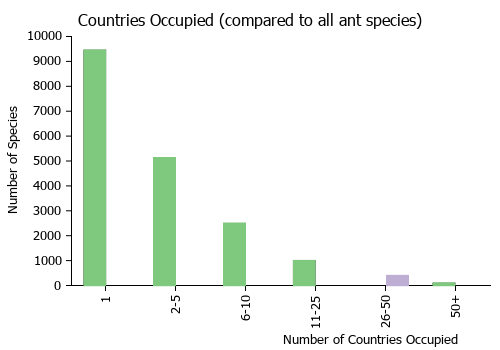
|
Estimated Abundance
| Relative abundance based on number of AntMaps records per species (this species within the purple bar). Fewer records (to the left) indicates a less abundant/encountered species while more records (to the right) indicates more abundant/encountered species. |

|
Biology
Wetterer and Hita Garcia (2015) - Widely distributed by human commerce. Free living in tropical and subtropical areas, also found in temperate areas associated with people in protected areas, e.g., greenhouses, zoos, heated buildings. The sum of the occurrence records suggest this species is fairly arid-adapted and does not favor heavily shaded sites such as forests or woodlands. It can be found in natural and disturbed habitats. Despite its wide distribution there is no evidence their presence produces any significant ecological effects.
Regional Notes
Espadaler (2007) - Canary Islands: Collected only from two urban sites.
Bharti and Kumar (2012) - India: Collected from a disturbed area with high anthropogenic activities. It is widely distributed in the tropics and subtropics, associated with man and living in hothouses, zoos or other constantly heated buildings (Bolton 1980). It is uncommon in India and is here reported for the first time.
Deyrup, Davis and Cover (2000) - Florida: A relatively uncommon species occurring as far north as Hernando County. Most specimens are from open disturbed areas, usually near buildings. Pest status: none. First published Florida record: Bolton 1979.
Sharaf et al (2018) - Oman This species was found nesting under a rock where the soil was dry and loose and in an area cultivated rose plantations. Tetramorium caldarium was also collected among leaf litter in a well-irrigated public park.
Life History Traits
- Queen number: polygynous (Frumhoff & Ward, 1992)
Castes
Worker
Images from AntWeb
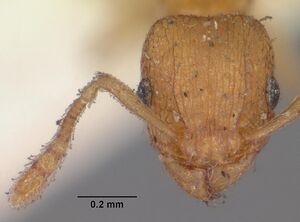  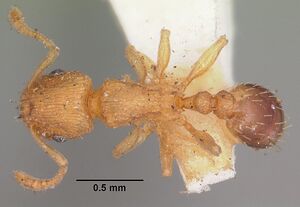 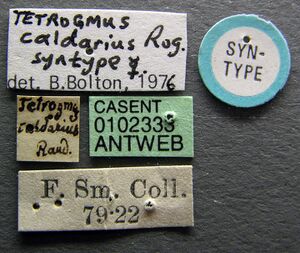
| |
| Worker. Specimen code casent0102333. Photographer April Nobile, uploaded by California Academy of Sciences. | Owned by NHMUK, London, UK. |
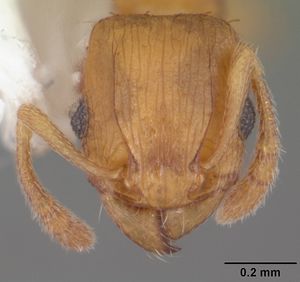  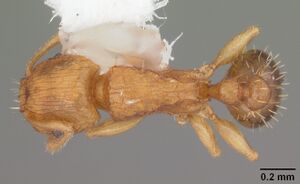 
| |
| Worker. Specimen code casent0102738. Photographer April Nobile, uploaded by California Academy of Sciences. | Owned by ABS, Lake Placid, FL, USA. |
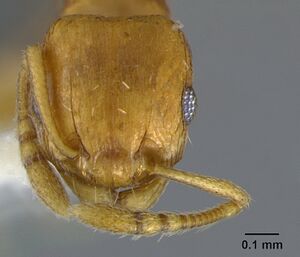 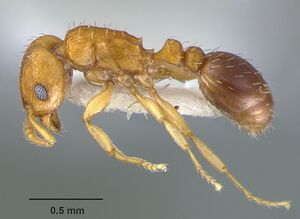  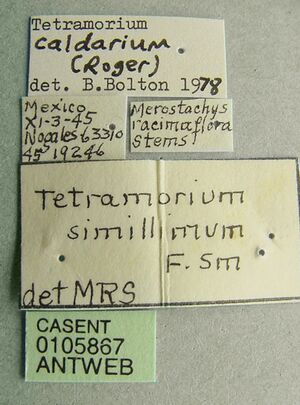
| |
| Worker. Specimen code casent0105867. Photographer Dan Kjar, uploaded by California Academy of Sciences. | Owned by USNM, Washington, DC, USA. |
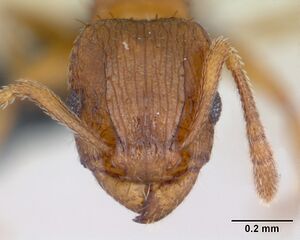  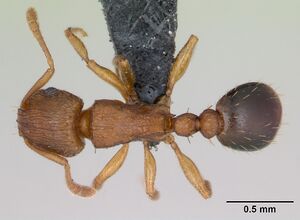 
| |
| Worker. Specimen code casent0125225. Photographer April Nobile, uploaded by California Academy of Sciences. | Owned by CAS, San Francisco, CA, USA. |
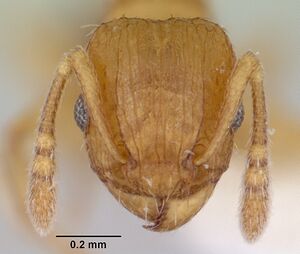 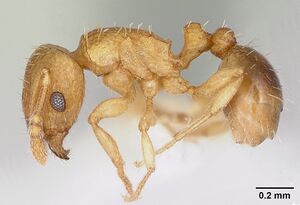 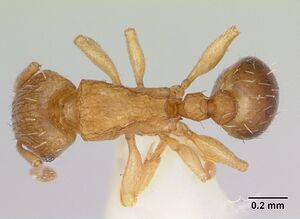 
| |
| Worker. Specimen code casent0173287. Photographer April Nobile, uploaded by California Academy of Sciences. | Owned by CDRS, Galapagos, Ecuador. |
 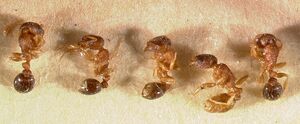
| |
| Worker. Specimen code casent0003150. Photographer April Nobile, uploaded by California Academy of Sciences. | Owned by AMNH, New York, NY, USA. |
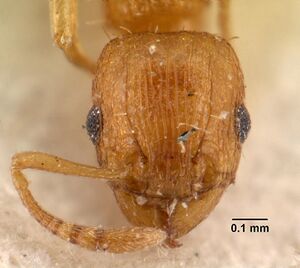  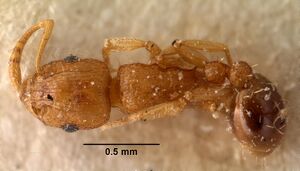 
| |
| Worker. Specimen code casent0101490. Photographer April Nobile, uploaded by California Academy of Sciences. | Owned by MNHN, Paris, France. |
Queen
Images from AntWeb
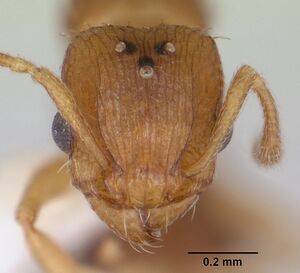 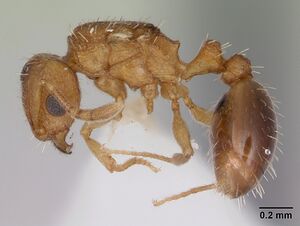 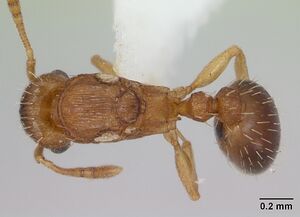 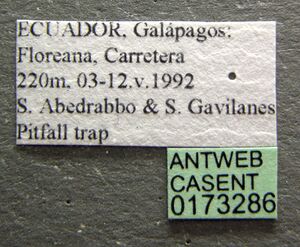
| |
| Queen (alate/dealate). Specimen code casent0173286. Photographer April Nobile, uploaded by California Academy of Sciences. | Owned by CDRS, Galapagos, Ecuador. |
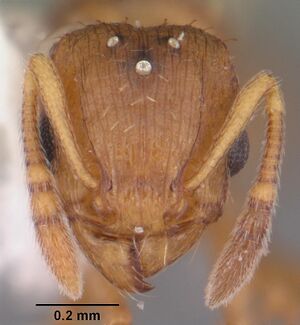  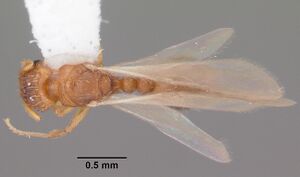 
| |
| Queen (alate/dealate). Specimen code casent0102739. Photographer April Nobile, uploaded by California Academy of Sciences. | Owned by ABS, Lake Placid, FL, USA. |
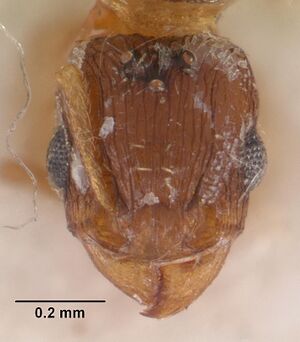 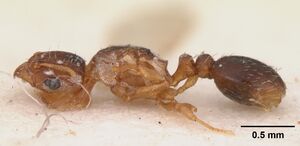  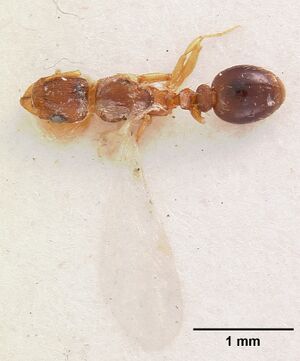 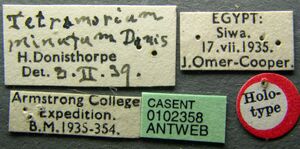
| |
| Queen (alate/dealate). Specimen code casent0102358. Photographer April Nobile, uploaded by California Academy of Sciences. | Owned by NHMUK, London, UK. |
Nomenclature
The following information is derived from Barry Bolton's Online Catalogue of the Ants of the World.
- caldarium. Tetrogmus caldarius Roger, 1857: 12 (w.q.) POLAND. Meinert, 1861: 331 (m.). Combination in Tetramorium: Bolton, 1979: 169. Junior synonym of simillimum: Roger, 1862c: 297. Revived from synonymy: Bolton, 1979: 169. Senior synonym of hemisi, minutum: Bolton, 1979: 169. See also: Czechowski, Radchenko & Czechowska, 2002: 68; Bharti & Kumar, 2012b: 21.
- hemisi. Tetramorium pusillum var. hemisi Wheeler, W.M. 1922a: 193 (w.) DEMOCRATIC REPUBLIC OF CONGO. Junior synonym of caldarium: Bolton, 1979: 169.
- minutum. Tetramorium minutum Donisthorpe, 1942a: 30 (q.) EGYPT. Junior synonym of caldarium: Bolton, 1979: 169.
Unless otherwise noted the text for the remainder of this section is reported from the publication that includes the original description.
Wetterer and Hita Garcia (2015) - T. caldarium was described by Roger (1857) from Poland, with the specimens collected from a greenhouse growing pineapples. This species was promptly (Roger 1862) synonymized under Tetramorium simillimum, where it remained until 1979 when Bolton revived its status as a valid species. Museum specimens of T. simillimum that do not have contemporary identifications need to be carefully evaluated to be sure they are not T. caldarium (see the identification section above for diagnostic characters).
Description
Worker
Bharti and Kumar (2012) - HL 0.63-0.64, HW 0.53-0.56, SL 0.42-0.45, EL 0.12-0.13, WL 0.66-0.69, PW 0.37-0.38, PSL 0.03-0.05, PTL 0.13-0.14, PPL 0.18-0.20, PTW 0.18-0.19, PPW 0.21-0.23, PTH 0.20-0.21, PPH 0.18-0.19, CI 84.13-87.50, OI 21.82-23.21, SI 76.36-83.02, PSLI 4.76-7.94, PeNI 47.37-51.35, LPeI 61.90-70.00, DPeI 128.57-146.15, PpNI 55.26-62.16, LPpI 94.74-105.56, DPpI 110.53-127.78, PPI 116.67-121.05 (9 measured).
Head longer than broad, sides almost straight, posterolateral corners rounded, posterior head margin shallowly emarginated; clypeus consisting of flat basal half and steep apical half; anterior margin of clypeus entire without median notch; mandibles triangular, with 6 teeth, masticatory margin of mandibles with large apical and preapical tooth; third tooth slightly smaller than the preapical tooth followed by three denticles; frontal lobes weakly developed and elevated laterally, frontal area indistinct; antennal scrobes feeble, indistinct, very little concave and not bordered posteriorly; eye moderate in size, located laterally and almost at mid-length of head, composed of ca. 8 ommatidia in a series along its maximum length; antennae slender, 12-segmented; scape short from posterior head margin by one fourth of its length; mesosoma longer than head, broader anteriorly than posteriorly, dorsum flat and tapers to backward in lateral view; pro-mesonotal suture and metanotal groove indistinct; propodeal teeth small (PSL 0.03-0.05mm), acute, triangular almost equal to its width and propodeal lobes; propodeal lobes broad and roughly triangular in shape; posterior declivity of propodeum short, concave; petiole with a short peduncle, its node as broad as long with anterior and posterior faces parallel, weakly convex dorsum in lateral view; ventrally petiole weakly downcurved along its length; peduncle with a small anteroventral lamella; postpetiole broader than long, gaster oval.
Head feebly longitudinally rugose, interrugal space weakly granular or punctulate; frontal carinae feeble and developed to the level of the midlength of the eye behind which fade out or broken; mandibles weakly longitudinally rugulose; clypeus with a strong mid and two lateral carinae; dorsum of mesosoma weakly granular or punctulate with traces of rugulose sculpture; sides of mesosoma reticulate; petiole and postpetiole faintly rugulose and punctulate; propodeal declivity reticulate, upper half finely transversely rugulose, gaster unsculptured; legs smooth and shiny.
Whole body yellowish brown with gaster darker brown; body with short, erect, stiff, blunt hairs and few scattered pubescence on gaster; antennal scapes and hind tibiae with very short, fine, appressed pubescence.
References
- Agavekar, G., Hita Garcia, F., Economo, E.P. 2017. Taxonomic overview of the hyperdiverse ant genus Tetramorium Mayr (Hymenoptera, Formicidae) in India with descriptions and X-ray microtomography of two new species from the Andaman Islands. PeerJ 5:e3800 (DOI 10.7717/peerj.3800).
- Bharti, H. & Kumar, R. 2012b. Taxonomic studies on genus Tetramorium Mayr, with report of two new species and three new records including a tramp species from India with a revised key. ZooKeys 207: 11-35.
- Bolton, B. 1979. The ant tribe Tetramoriini (Hymenoptera: Formicidae). The genus Tetramorium Mayr in the Malagasy region and in the New World. Bull. Br. Mus. (Nat. Hist.) Entomol. 38: 129-181 (page 169, Revived from synonymy, combination in Tetramorium, and senior synonym of hemisi and minutum)
- Bolton, B. 1980. The ant tribe Tetramoriini (Hymenoptera: Formicidae). The genus Tetramorium Mayr in the Ethiopian zoogeographical region. Bull. Br. Mus. (Nat. Hist.) Entomol. 40: 193-384 (page 310, Senior synonym of transformans)
- Borowiec, L. 2014. Catalogue of ants of Europe, the Mediterranean Basin and adjacent regions (Hymenoptera: Formicidae). Genus (Wroclaw) 25(1-2): 1-340.
- Collingwood, C. A., Pohl, H., Guesten, R., Wranik, W. and van Harten, A. 2004. The ants (Insecta: Hymenoptera: Formicidae) of the Socotra Archipelago. Fauna of Arabia. 20:473-495.
- Czechowski, W., Radchenko, A., Czechowska, W. 2002. The ants (Hymenoptera, Formicidae) of Poland. MIZ PAS Warsaw.
- Dekoninck, W., Wauters, N., Delsinne, T. 2019. Capitulo 35. Hormigas invasoras en Colombia. Hormigas de Colombia.
- Deyrup, M., Davis, L. & Cover, S. 2000. Exotic ants in Florida. Transactions of the American Entomological Society 126, 293-325.
- Deyrup, M.A., Carlin, N., Trager, J., Umphrey, G. 1988. A review of the ants of the Florida Keys. Florida Entomologist 71: 163-176.
- Guillem, R., Bensusan, K. 2022. Thee new exotic species of ants (Hymenoptera, Formicidae) for Madeira, with comments on its myrmecofauna. Journal of Hymenoptera Research 91: 321–333 (doi:10.3897/jhr.91.81624).
- Herrera, H.W., Baert, L., Dekoninck, W., Causton, C.E., Sevilla, C.R., Pozo, P., Hendrickx, F. 2020. Distribution and habitat preferences of Galápagos ants (Hymenoptera: Formicidae). Belgian Journal of Entomology, 93: 1–60.
- Heterick, B.E. 2021. A guide to the ants of Western Australia. Part I: Systematics. Records of the Western Australian Museum, Supplement 86, 1-245 (doi:10.18195/issn.0313-122x.86.2021.001-245).
- Heterick, B.E. 2022. A guide to the ants of Western Australia. Part II: Distribution and biology. Records of the Western Australian Museum, supplement 86: 247-510 (doi:10.18195/issn.0313-122x.86.2022.247-510).
- Lamelas-Lopez, L., Gabriel, R., Ros-Prieto, A., Borges, P. 2023. SLAM Project - Long Term Ecological Study of the Impacts of Climate Change in the natural forest of Azores: VI - Inventory of Arthropods of Azorean Urban Gardens. Biodiversity Data Journal 11, e98286 (doi:10.3897/bdj.11.e98286).
- Lubertazzi, D. 2019. The ants of Hispaniola. Bulletin of the Museum of Comparative Zoology, 162(2), 59-210 (doi:10.3099/mcz-43.1).
- Meinert, F. 1861. Bidrag til de danske Myrers Naturhistorie. K. Dan. Vidensk. Selsk. Skr. (5) 5: 273-340 (page 331, male described)
- Meurgey, F. 2020. Challenging the Wallacean shortfall: A total assessment of insect diversity on Guadeloupe (French West Indies), a checklist and bibliography. Insecta Mundi 786: 1–183.
- Nsengimana, V., Hagenimana, T., Barakagwira, J., de Dieu Nsenganeza, J., Iradukunda, S. C., Majyambere, M., Kizungu, O. B., Nkundimana, A., Umutoni, D., Fabrice, R., Cyubahiro, B., Kouakou, L. M., Kolo, Y., Anale, J. S., Gómez, K., Dekoninck, W. 2023. Checklist of ant (Hymenoptera: Formicidae) species from Nyungwe Tropical Rain Forest, south-western Rwanda. Journal of East African Natural History 111(2), 69-81 (doi:10.2982/028.111.0203).
- Oussalah, N., Marniche, F., Espadaler, X., Biche, M. 2019. Exotic ants from the Maghreb (Hymenoptera, Formicidae) with first report of the hairy alien ant Nylanderia jaegerskioeldi (Mayr) in Algeria. Arxius de Miscel·lània Zoològica, 45–58 (doi:10.32800/amz.2019.17.0045).
- Pawluk, F., Borowiec, L., Salata, S. 2022. First record of Plagiolepis alluaudi Emery, 1894 (Hymenoptera: Formicidae) from Poland. Annals of the Upper Silesian Museum in Bytom Entomology 31 (online 006) 1-5 (doi:10.5281/ZENODO.6522444).
- Roger, J. 1857. Einiges über Ameisen. Berl. Entomol. Z. 1: 10-20 (page 12, worker, queen described)
- Roger, J. 1862c. Synonymische Bemerkungen. 1. Ueber Formiciden. Berl. Entomol. Z. 6: 283-297 (page 297, Junior synonym of simillimum)
- Rosas-Mejía, M., Guénard, B., Aguilar-Méndez, M. J., Ghilardi, A., Vásquez-Bolaños, M., Economo, E. P., Janda, M. 2021. Alien ants (Hymenoptera: Formicidae) in Mexico: the first database of records. Biological Invasions 23(6), 1669–1680 (doi:10.1007/s10530-020-02423-1).
- Salata, S., Khalili-Moghadam, A., Borowiec, L. 2024. A new species of the Tetramorium meridionale species-group (Hymenoptera: Formicidae) from Iran. Zoology in the Middle East 70, 161–175 (doi:10.1080/09397140.2024.2359167).
- Sanetra, M., Buschinger, A. 2000. Phylogenetic relationships among social parasites and their hosts in the ant tribe Tetramoriini (Hymenoptera: Formicidae). European Journal of Entomology 97: 95-117.
- Sharaf, M. R. , B. L. Fisher, H. M. Al Dhafer, A. Polaszek and A. S. Aldawood. 2018. Additions to the ant fauna (Hymenoptera: Formicidae) of Oman: an updated list, new records and a description of two new species. Asian Myrmecology. 9:e010004; 1-38. doi:10.20362/am.010004
- Sharaf, M. R., Wetterer, J. K., Mohamed, A. A., Aldawood, A. S. 2022. Faunal composition, diversity, and distribution of ants (Hymenoptera: Formicidae) of Dhofar Governorate, Oman, with updated list of the Omani species and remarks on zoogeography. European Journal of Taxonomy 838: 1-106 (doi:10.5852/ejt.2022.838.1925).
- Sharaf, M.R., Abdel-Dayem, M.S., Mohamed, A.A., Fisher, B.L., Aldawood, A.S. 2020. A preliminary synopsis of the ant fauna (Hymenoptera: Formicidae) of Qatar with remarks on the zoogeography. Annales Zoologici 70: 533-560 (doi:10.3161/00034541anz2020.70.4.005).
- Sharaf, M.R., Fisher, B.L., Collingwood, C.A., Aldawood, A.S. 2017. Ant fauna (Hymenoptera: Formicidae) of the Socotra Archipelago (Yemen): zoogeography, distribution and description of a new species. Journal of Natural History 51, 317–378 (DOI 10.1080/00222933.2016.1271157).
- Taylor, B., Agoinon, N., Sinzogan, A., Adandonon, A., Kouaguou, Y. N., Bello, S., Wargui, R., Anato, F., Ouagoussounon, I., Houngbo, H., Tchibozo, S., Todjihounde, R., Vayssieres, J.F. 2018. Records of ants (Hymenoptera: Formicidae) from the Republic of Benin, with particular reference to the mango farm ecosystem. Journal of Insect Biodiversity 8(1): 6-29 (doi:10.12976/jib/2018.08.1.2).
- Trigos-Peral, G., Abril, S., Angulo, E. 2020. Behavioral responses to numerical differences when two invasive ants meet: the case of Lasius neglectus and Linepithema humile. Biological Invasions (doi:10.1007/s10530-020-02412-4).
- Wetterer, J.K. 2017. Invasive ants of Bermuda revisited. Journal of Hymenoptera Research 54, 33–41 (doi:10.3897/jhr.54.11444).
- Wetterer, J.K., Espadaler, X., Ashmole, N.P., Mendel, H., Cutler, C., Endeman, J. 2007. Ants (Hymenoptera: Formicidae) of the South Atlantic islands of Ascension Island, St Helena, and Tristan da Cunha. Myrmecological News 10: 29-37.
- Wetterer, J.K., Hita Garcia, F. 2015. Worldwide spread of Tetramorium caldarium (Hymenoptera: Formicidae). Myrmecological News 21:93-99.
- Wetterer, J.K., Wetterer, A.L. 2004. Ants (Hymenoptera: Formicidae) of Bermuda. Florida Entomologist 87(2), 212–221 (doi:10.1653/0015-4040(2004)087[0212:ahfob2.0.CO;2]).
References based on Global Ant Biodiversity Informatics
- Bolton B. 1980. The ant tribe Tetramoriini (Hymenoptera: Formicidae). The genus Tetramorium Mayr in the Ethiopian zoogeographical region. Bulletin of the British Museum (Natural History). Entomology 40: 193-384.
- Collingwood C.A., and A. Van Harten. 1993. The ants (Hymenoptera: Formicidae) of the Cape Verde Islands. Beitrag zur Fauna und Flora der Kapverdischen Inseln : Ergebnisse des 5. Symposiums in Leiden 159: 411-414.
- Dieng M. M., A. B. Ndiaye, C. T. Ba, and B. Taylor. 2016. Les fourmis (Hymenoptera, Formicidae) de l’enclos d’acclimatation de Katane de la reserve de faune du Ferlo nord (Senegal). Int. J. Biol. Chem. Sci. 10(4): 1626-1636.
- Garcia F.H., Wiesel E. and Fischer G. 2013.The Ants of Kenya (Hymenoptera: Formicidae)Faunal Overview, First Species Checklist, Bibliography, Accounts for All Genera, and Discussion on Taxonomy and Zoogeography. Journal of East African Natural History, 101(2): 127-222
- Kouakou L. M. M., K. Yeo, K. Ouattara, W. Dekoninck, T. Delsinne, and S. Konate. 2018. Investigating urban ant community (Hymenoptera: Formicidae) in port cities and in major towns along the border in Côte d’Ivoire: a rapid assessment to detect potential introduced invasive ant species. Journal of Animal and Plant Sciences 36(1): 5793-5811.
- Kouakou L. M. M., W. Dekoninck, M. Kone, T. Delsinne, K. Yeo, K. Ouattara, and S. Konate. 2018. Diversity and distribution of introduced and potentially invasive ant species from the three main ecoregions of Côte d’Ivoire (West Africa). Belgian Journal of Zoology 148 (1): 83–103.
- Taylor B., N. Agoinon, A. Sinzogan, A. Adandonon, Y. N'Da Kouagou, S. Bello, R. Wargui, F. Anato, I. Ouagoussounon, H. Houngbo, S. Tchibozo, R. Todjhounde, and J. F. Vayssieres. 2018. Records of ants (Hymenoptera: Formicidae) from the Republic of Benin, with particular reference to the mango farm ecosystem. Journal of Insect Biodiversity 8(1): 006–029.
- Wetterer J. K., X. Espadaler, A. L. Wetterer, D. Aguin-Pombo, and A. M. Franquinho-Aguiar. 2006. Long-term impact of exotic ants on the native ants of Madeira. Ecological Entomology 31: 358-368.
- Wetterer J. K., X. Espadaler, A. L. Wetterer, D. Aguin-Pombo, and A. M. Franquinho-Aguiar. 2007. Ants (Hymenoptera: Formicidae) of the Madeiran archipelago. Sociobiology 49: 265-297.
- Wetterer J. K., and F. Hita Garcia. 2015. Worldwide spread of Tetramorium caldarium (Hymenoptera: Formicidae). Myrmecological News 21: 93-99.
- Wheeler W. M. 1922. Ants of the American Museum Congo expedition. A contribution to the myrmecology of Africa. II. The ants collected by the American Museum Congo Expedition. Bulletin of the American Museum of Natural History 45: 39-269.
